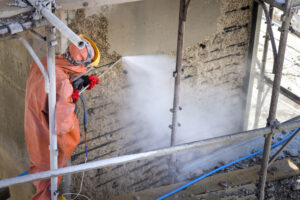
Road and Bridge Repair with Waterjets
By Diane M. Calabrese / Published December 2023

The Golden Gate in San Francisco and the Brooklyn, NY, bridges have such star quality they figure often in films. It’s not easy to be such standouts. After all, there are more than 610,000 highway bridges in the United States.
The Federal Highway Administration (FHWA) is part of the U.S. Department of Transportation (DOT) and has responsibility for bridge management. We will go a bit deeper into the FHWA’s Office of Bridges and Structures in the last section.
Whether a glittering symbol of perseverance, a reliably functional structure, or some of each (e.g., a hidden beauty), bridges, like roads, must be maintained. Anything less than serious routine attention invites calamity.
Waterjet tools are out there making the work of maintenance as expeditious and safe as possible. Also on the roster of tools are sand blasting, solvents, and more. In projects where the force of water can substitute for adding substances to the waste stream, the environment gains.
“Pressure washers and waterjet units have made a huge different in bridge repairs,” explains Brad Howland, president of PowerJet Pressure Cleaning Systems in Sussex Corner, NB, Canada. “Painted steel bridges need constant cleaning and repainting every few years.”
Surface preparation for new coatings and removal of material that could conceal potential trouble spots are both part of the maintenance and repair scheme. Visibility for inspection is a must.
“We have many bridges that instead of being sandblasted are descaled with hot high-pressure water,” says Howland. He adds that the specification of equipment ranges from 5 gpm at 5000 psi to 8 gpm at 8000 psi to 6 gpm at 11,500 psi, at 200°F achieved with diesel engine-driven hot water.
The capabilities of waterjet machines make them a contender in the competition with abrasives and solvents. “These machines will strip the paint—the hot water shocks the paint off and removes the rust,” says Howland.
“Sandblasting can still be specified on these jobs, although higher pressure hot-water units are most always on the job working as well,” says Howland. “The sand must be vacuumed up in a reclaim system whereas the water does not have to be.”
There are other positives tied to the deployment of waterjets. Cost savings is one. “Lower pressure is used in a pressure washer versus sandblast compressors and reclaim equipment; therefore, the cost of operation is less to perform the work,” says Howland.
High-pressure equipment is also out there in the service of maintaining roads. For instance, Howland’s company manufactures an 8 gpm at 8000 psi hot diesel drive unit for removing painted lines on roadways. “It helps road workers and is very cost effective for them,” he explains.
First, do no damage is the rule in challenging projects. Road maintenance is no exception. The millions of miles of pipelines (including sewers) coursing under roadways creates an ongoing challenge: Maintain the lines without unnecessary damage to paved surfaces.
“We manufacture large dry steam generators to help sewer contractors in the sewer line refurbishment business who must cure liners,” says Howland. “This saves a huge cost. The sewer line does not have to be replaced by digging up the road as it is repaired in place.”
Bridge to the Future
The Golden Gate Bridge was completed in 1937, the culmination of a four-year effort. The Brooklyn Bridge was completed in 1883, or 14 years after construction started in 1869.
Two wonderful structures that demonstrated the trajectory of industry, which continues to enable faster and safer construction. It’s a trajectory we are still on, and along which we are moving even faster.
“Automation is the way of the future for an increasing number of industries, including waterblasting,” says Jordan Koster, product and marketing manager for Jetstream of Houston LLP in Houston, TX. Safety and efficiency are bolstered because of it.
“Robotic sprayers drastically improve safety by taking on the most physically demanding aspects of this task and moving the operator farther away from the high-pressure water,” explains Koster. “Automation also boosts efficiency with the ability to work faster and with smaller crews.”
 In the 21st century, design engineers look at performance and outcomes in the context of efficiency and safety. Doing more with less is a philosophy that transcends industries.
In the 21st century, design engineers look at performance and outcomes in the context of efficiency and safety. Doing more with less is a philosophy that transcends industries.
Heavy-duty projects are no exception. “We designed and manufactured our 5200Q Bareshaft pump with these heavy-duty projects in mind,” says Koster. “This waterblasting pump rises to the occasion to meet big water needs, with flow capabilities up to 136 gpm and 40,000 psi.”
Not only does the pump couple high flow and force, but it also incorporates features that simplify the day for its operators. “The ability to change out packing, univalves, and plungers in just five minutes minimizes downtime and offers the efficiency contractors need to keep up with the automated equipment,” says Koster.
Versatility of equipment can also enhance efficiency, and it gets built into equipment to the extent possible.
“As any foreman knows, road resurfacing and bridge repair entail varying degrees of concrete removal,” says Koster. “The 5200Q’s swappable fluid ends allow crews to easily swap between pressure ranges for a smooth transition from scarification to total concrete removal.”
Always keep your eyes on the road, but it’s okay to take in the scene of bridge and road rehabilitation when traffic gets halted.
“If you’ve ever driven through Colorado, Utah, or a variety of other western states, you’re probably familiar with I-70,” says Koster. Recall some of the bridges and panoramic views on that stretch.
“A few years ago the Utah Department of Transportation had 14 bridges in disrepair,” explains Koster. “Instead of replacing every bridge deck—a tedious and inefficient process—they determined that using waterjetting methods to remove the concrete would save $15 million while extending deck longevity by as much as 25 years.”
It was equipment—Aquajet robots and a Jetstream 650 TwinForce waterblasting unit—from Koster’s company that served the contractor in charge of the Utah DOT project. Koster’s company offers the equipment through its dedicated rental stores.
The result of the pairing of the cutting-edge equipment? “This combo allowed them to efficiently remove 3,300 cubic yards of concrete, highlighting the benefits of using a variety of waterblasting equipment for road and bridge repair,” says Koster.
Maintenance and Management
What would the operators of steam-powered shovels used in building the cable-stayed/suspension bridge across the East River to connect Brooklyn and Manhattan think of robotically controlled jetting equipment? They would probably seize on the similarities (as well as differences) despite the 150 years that have elapsed since completion of the Brooklyn Bridge. In another 150 years? It’s a lot to consider.
Meanwhile, contractors working on bridge and road rehabilitation projects in the United States must comply with regulations coming from federal entities. For example, the Office of Bridges and Structures at the FHWA has a stewardship and oversight function for highway bridges (610,000-plus) and tunnels (500-plus) along federal highways.
Through the office, the FHWA distributes $7 billion to assist transportation agencies with planning, rehabilitation, and inspection. It also does much more, including compiling and assessing technical advances related to bridge engineering, from seismic and hydraulic issues to security.
National Bridge Inspection Standards (23 CFR Part 650, Subpart C) (NBIS) yoke in any contractor working on bridge rehabilitation. States are responsible for inspection of all bridges within their boundaries except for those that are federally or tribally owned.
Bridge inspectors—certified by meeting criteria established by the federal government—look well beyond the big things like load rating. They look closely at the smallest bridges and check the effects of scouring along stream beds on bridge supports.
States bear responsibility for all in-state municipalities and local entities that own bridges, should the subordinate jurisdictions fail to inspect them correctly. In short, contractors tackling bridge and road repair must meet exacting specifications.
In November 2020, the FHWA hosted a Bridge Management Systems Workshop. The 831-page workshop document is available in the digital sphere in pdf format (www.fhwa.dot.gov/bridge/management/FHWA_BMS_workbook_1120.pdf). For contractors thinking about bidding on bridge rehabilitation projects or joining a larger contractor as a subcontractor, the document provides an excellent introduction.
As manufacturers who already serve the bridge and highway sector know, bridge owners must evaluate the cost and benefit of maintaining structures. Cleaning steel in preparation for repainting might lead to discoveries that change the direction of a project.
A deck surface that is contaminated or spalled can be patched. Replacement is the requirement for a worn strip seal expansion joint. Some deck cracking can be fixed with an overlay. A damaged deck bottom must be replaced.
Detailed specifications, scrutiny from owners and regulatory entities, and difficult settings (e.g., working high up and working around traffic) make road and bridge repair efforts complex. By cutting the number of team members required on site, separating operators and equipment with robotic controls, speeding processes, and reducing waste streams, waterjet tools make it all easier.
Prudence in maintaining roads and bridges increases their longevity. That’s a big savings for taxpayers. It also ensures the small beauties in the bridge constellation will continue to amaze along with the big stars.


